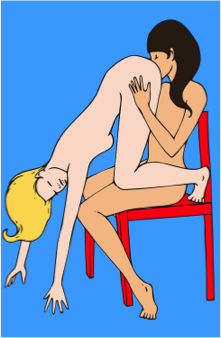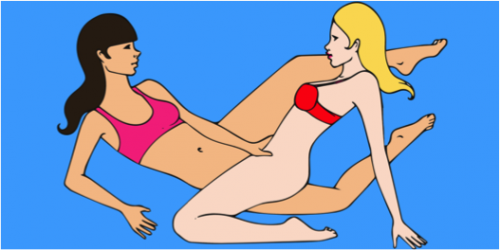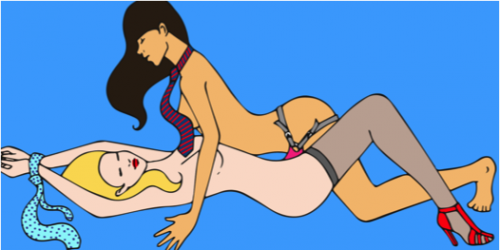Cosmo’s 28 Not-So-Sexy Tips for “Lady-Lovers”
**Please note that this post has illustrations of sexual acts.**
Recently, and for the first time ever, Cosmopolitan Magazine published a list of sex tips and positions for “lesbians, bisexuals, pansexuals, queers- all lady-loving ladies in the crowd.” At first, as a member of the LGBTQQIAA community, I was shocked and excited at the seemingly legitimate public recognition of my sexual practices by the “sex gurus” themselves over at Cosmo. At a closer glance however, this list is a comical illustration that is not titillating to say the least, but ultimately is quite exclusionary in the understanding of lesbian sex. Needless to say, the lesbian sex Cosmo describes is not my sex, let alone a realistic portrait of most “lady-loving” relationships.
Let me give you some examples. There are some pretty good critiques online about the feasibility of these positions, but there is more to it than just that. Take a look:

Source: http://www.cosmopolitan.com/sex-love/positions/g4090/mind-blowing-lesbian-sex-positions/?thumbnails
This first move, entitled Defying Gravity, with a difficulty rating of five “hearts” out of five requires the receiving partner to face away from her partner, kneel, straddle and bend over so her hips are in the air and her hand touch the ground for support. Even after nine years of competitive gymnastics in my childhood, this move would require great strength and flexibility to maneuver and support oneself. I immediately think about dis/ability discourses when looking at images like this and how they potentially exclude and erase women who are not physically capable to perform such an acrobatic act. Did and would the writers even consider varying the images to include a wider representation of individuals and possibilities?

Source: http://www.cosmopolitan.com/sex-love/positions/g4090/mind-blowing-lesbian-sex-positions/?thumbnails
In this second image, which Cosmo so cleverly entitled “The Classic Scissor,” two women are illustrated straddling one another so that their clitorises may rub together. This move is not new. There is a longstanding history of lesbian sex. Cosmo even acknowledges that it is a “classic.” Yet, because of the magazine’s “authority” on all topics related to sex, they receive credit for naming this “classic” sex move. This renaming and rebranding of lesbian culture delegitimizes every stride for recognition and legitimacy that the lesbian movement has made. Only when Cosmo says that this sexual move is pleasurable—is legitimate—can women have sexual relationships with one another. But we know that this is not the case, and so do they.

Source: http://www.cosmopolitan.com/sex-love/positions/g4090/mind-blowing-lesbian-sex-positions/?thumbnails
And of course, my favorite of the sex moves (to critique) is number eighteen: the “Strap-on Sizzle.” Look closely. The woman on the top wearing the strap-on is hyper-masculinized by wearing a tie, while the submissive bottom receiving the strap-on penetration is hyper-feminized by being tied up and illustrated wearing lipstick, thigh high pantyhose and strappy red heels. In this image, Cosmo takes the strap-on and equates it as close to heterosexual sex with gender role-play as possible. Women, in this case, cannot legitimately be penetrated by anything other than a man.
What else, I ask you, is depicted or not depicted in these images? What messages are being conveyed through this listing? How are lesbian relationships (and supposedly other non-heterosexual relationships) being constructed?
First, besides the hyper-masculinization of the women wearing strap-ons, the lesbians are extremely feminine with long flowing hair, sexy lingerie, heels, makeup, and jewelry. It’s as if there can only be one type of lesbian- the “femme” or “lipstick lesbian” (which is arguably two types, but still both feminine). What about short-haired lesbians? Dykes? Butches? Women who aren’t a size two?
Secondly, the two women in the images arguably both pass for white with one fair-skinned blonde and another a more olive-toned brunette. At first I thought about the possibility of an inter-racial couple, which is still a possibility, but the fact of the matter is that both partners pass for white. If this list is supposed to be for all “lady-loving ladies,” what is it doing to say who qualifies to be a true woman? What qualifies for a legitimate lesbian relationship? On that note, what about other types of relationships, as the post is supposedly intended for pansexuals, queers, and any “lady lover”?
What irks me the most (I don’t know why this irks me so much) is the fact that in every image the women’s nipples and vulvas are covered, as if these imaginary women need their sanctity to be protected because they are women! Either way, with or without the illustration of these “private” parts, these images are about sex and depict sexual acts. They are still pornographic, why must we preserve womanhood? These images clearly define lesbian relationships to be monogamous sexual acts between two femme women in the traditional gendered sense, with no penetration involved (unless role play to mimic heterosexual gender roles is involved) because a sexual relationship between two women is not equated with a heterosexual relationship.
This brings me to my question and conclusion. Who is this list really for? I do acknowledge that there is some recognition of some lesbian relationships, as there are some couples who participate in these acts and look like these women. It is nice for the “sex gurus” to publish something relatively positive about non-heterosexual relationships, as not all LGBTQ identified individuals have access to other resources or have had sex. Obviously, however, this post was not meant for all lesbians or “lady loving ladies” (in which Cosmo equates the two). I believe it is safe to conclude that this “inclusion” of lesbian sex tips is merely a marketing strategy to cause a commotion and to provide “titillating” fantasy for unknowledgeable heterosexual readers, because obviously Cosmo still does not understand nor want to legitimate my relationships.
Future Reading:
Saraceno, Michael J and Rachel B Tambling. 2013. “The Sexy Issue: Visual Expressions of Heteronormativity and Gender Identities in Cosmopolitan Magazine.” The Qualitative Report 18(40):1.
McMahon, K. 1990. “The Cosmopolitan Ideology and the Management of Desire.” Journal of Sex Research 27(90):381-396.
Dow, B. 2001. “Ellen, Television, and the Politics of Gay and Lesbian Visibility.” Critical Studies in Media Communication 18(2)




1475-6781/asset/JSS.gif?v=1&s=377bb8e0c3d0fcf201f301ded7cf610142072c3e)
1530-2415/asset/SPSSI_logo_small.jpg?v=1&s=703d32c0889a30426e5264b94ce9ad387c90c2e0)